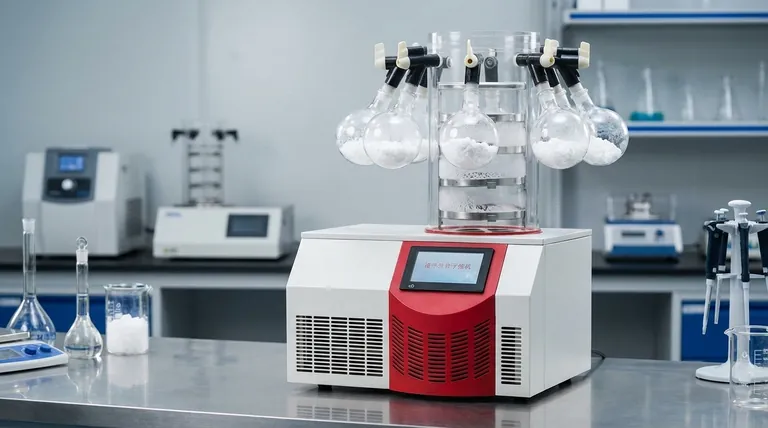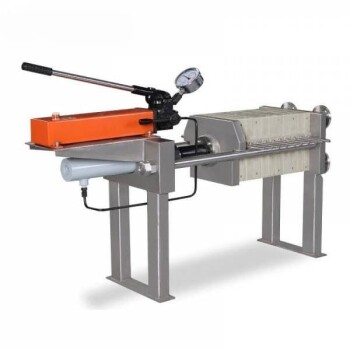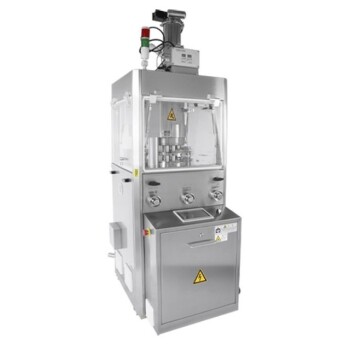In lyophilization, crystalline materials are defined by their ability to form an ordered, rigid structure upon freezing. This structure possesses a distinct melting point known as the eutectic temperature (Te), which serves as the critical temperature limit during the drying process. The efficiency and success of lyophilizing these materials are directly dependent on the size of the crystals formed, which is controlled by the freezing rate.
The core challenge with crystalline formulations is not if they can be freeze-dried, but how efficiently. Success hinges on controlling the freezing process to create large crystals for rapid drying, while strictly maintaining the product temperature below its eutectic point to prevent process failure.

The Defining Properties of Crystalline Solutes
To control the lyophilization process, you must first understand the fundamental behavior of crystalline materials as they freeze.
The Formation of a Crystal Lattice
When a solution containing a crystalline solute (like mannitol or simple salts) is frozen, the solute molecules organize themselves into a highly ordered, repeating three-dimensional structure known as a crystal lattice. This is fundamentally different from amorphous materials, which solidify into a disordered, "glassy" state.
The Critical Eutectic Temperature (Te)
A crystalline formulation has a sharp, well-defined melting point called the eutectic temperature (Te). This is the lowest possible melting point for the mixture of solute and ice, where both components melt simultaneously.
During primary drying, the product temperature must be kept below this eutectic point. If the temperature rises above Te, the frozen structure will melt—a catastrophic failure known as "meltback"—leading to product collapse and a failed batch.
How Freezing Rate Dictates Drying Success
The physical structure of the frozen cake determines how quickly water vapor can escape during sublimation. This structure is a direct result of how you freeze the product.
Fast Freezing: Small Crystals, Slow Drying
Rapidly lowering the temperature causes a large number of seed crystals to form at once, resulting in a network of very small ice and solute crystals.
This creates a dense, tightly packed cake with low permeability. The small pores offer high resistance to water vapor flow, significantly slowing down the sublimation process and extending primary drying times.
Slow Freezing: Large Crystals, Faster Drying
Conversely, a slower, more controlled freezing rate allows for the growth of larger, more uniform crystals.
A cake composed of large crystals is more porous and has larger channels for vapor to escape. This low-resistance structure permits much faster sublimation, dramatically reducing primary drying time.
The Power of Annealing
Annealing is a thermal treatment step designed to optimize crystal size after the initial freeze. The product is held at a temperature just below the eutectic point for a period of time.
This process allows smaller, less stable crystals to melt and recrystallize onto larger, more stable ones. The result is an increase in the average crystal size, which enhances cake permeability and accelerates the subsequent drying phase.
Understanding the Trade-offs: Crystalline vs. Amorphous
Choosing or working with a crystalline formulation involves distinct advantages and disadvantages compared to amorphous ones.
Processing Advantage: Higher Collapse Temperature
Crystalline materials are often considered easier to lyophilize because their collapse temperature (the eutectic point) is typically higher than the glass transition temperature (Tg') of amorphous products. This allows for more "aggressive" primary drying cycles at warmer temperatures, which speeds up the process considerably.
Formulation Challenge: The Need for Control
The primary challenge for crystalline formulations is managing crystal size. An uncontrolled or overly rapid freeze can create a cake with such small crystals that the drying time becomes impractically long. Process development must focus on creating a robust freezing protocol that ensures large crystal formation.
In Contrast: Amorphous Materials
Amorphous materials (often complex mixtures) do not form crystals. Instead, they solidify into a viscous, glassy state. Their critical temperature is the glass transition temperature (Tg'), the point where the glassy solid begins to soften and flow. Drying must occur below Tg' to prevent collapse, and this temperature is often much colder than a typical Te, mandating longer, more conservative drying cycles.
How to Apply This to Your Process
Understanding these characteristics allows you to troubleshoot issues and optimize your lyophilization cycle.
- If your primary focus is process speed and robustness: A crystalline formulation is often superior, as its higher eutectic temperature permits faster and more efficient primary drying.
- If you are experiencing impractically long drying times with a crystalline product: The root cause is almost certainly small crystal size. You should introduce an annealing step or slow down the initial freezing rate.
- If you are unsure of your formulation's behavior: Performing thermal analysis (like Differential Scanning Calorimetry) is essential to identify whether you have a eutectic melt (Te) or a glass transition (Tg'), which dictates your entire process strategy.
By mastering the relationship between freezing rate, crystal size, and the eutectic temperature, you gain direct control over the efficiency and success of your lyophilization cycle.
Summary Table:
| Characteristic | Impact on Lyophilization |
|---|---|
| Eutectic Temperature (Te) | Critical max temperature during drying; meltback occurs above Te. |
| Crystal Size (from freezing rate) | Large crystals = fast drying; small crystals = slow drying. |
| Annealing | Thermal treatment to increase crystal size for faster sublimation. |
| Structure | Ordered, rigid crystal lattice allows for higher collapse temperature vs. amorphous materials. |
Optimize Your Lyophilization Process with KINTEK
Struggling with long drying times or process failures? The key to efficient lyophilization lies in precise control of crystalline materials. KINTEK specializes in the lab equipment and consumables that empower you to master this control.
We provide the tools and expertise to help you:
- Determine critical temperatures like the eutectic point (Te) for your formulation.
- Develop robust freezing and annealing protocols to ensure optimal crystal size.
- Achieve faster, more reliable primary drying cycles and maximize your lab's productivity.
Let our solutions bring clarity and efficiency to your laboratory's freeze-drying challenges. Contact our experts today to discuss your specific needs and how we can support your success.
Visual Guide

Related Products
- Benchtop Laboratory Freeze Dryer for Lab Use
- Benchtop Laboratory Vacuum Freeze Dryer
- Laboratory Sterilizer Lab Autoclave Pulse Vacuum Lifting Sterilizer
- Laboratory Sterilizer Lab Autoclave Vertical Pressure Steam Sterilizer for Liquid Crystal Display Automatic Type
- Laboratory Test Sieves and Sieving Machines
People Also Ask
- What types of liquid samples can be processed using a laboratory freeze dryer? Preserve Your Sensitive Materials
- What is the freeze drying or lyophilisation process? A Guide to Gentle, High-Quality Dehydration
- Why is freeze drying considered more effective than ordinary drying? Preserve Structure, Nutrients & Flavor
- Why are laboratory freeze dryers considered economical tools? Maximize Value and Minimize Loss
- What is the primary function of a freeze dryer in a laboratory setting? Preserve Delicate Materials with Sublimation



















